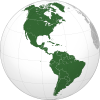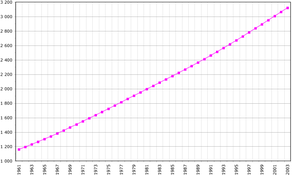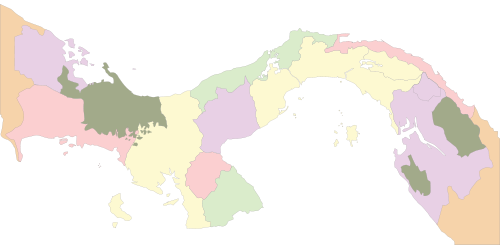- Demographics of Panama
-
This article is about the demographic features of the population of Panama, including population density, ethnicity, education level, health of the populace, economic status, religious affiliations and other aspects of the population.
Ethnic and Racial origins
The culture, customs, and language of Panama is predominantly Caribbean Spanish. Panama has a very diverse population which is largely of mixed Spanish, black, and Native American descent/ancestry. According to the CIA World Factbook, Panama has a population of more than 3,400,000; 70% is mestizo (mixed white, Native American, and/or black) and mulattoes (mixed white, and black ancestry), 14% is primarily black and mulattoes, 10% white and 6% Native Americans. Some East Asians like the Chinese are less than one percent.[citation needed]
Immigration
Immigration to Panama are represented by ethnic groups in the 19th and 20th centuries: British and Irish, Dutch, French, Germans, Italians, Portuguese, Poles, Russians or Ukrainians (a large number are Jews), U.S. Americans and West Indies/Caribbean (esp. Afro-Caribbean) nationalities, in which thousands of Barbadian and Jamaican workers played a role in the construction of the Panama Canal. Also important was the immigration of Arabs and Asians: in particular Chinese, Lebanese, Palestinians, South Asians (from India and Pakistan) and Syrians.
Religion
The majority of Panamanians are Christian, most are Roman Catholics by centuries of Spanish colonial influence. Other faiths exist in Panama by the country's tolerance and freedom of religion, there are large Protestant, Jewish,Baha, Muslim and Hindu religious groups in Panama. One known Panamanian of the Jewish faith was baseball player Rod Carew.[citation needed]
Languages
Many languages, including seven indigenous languages, are spoken in Panama, although Spanish is the official and dominant language. English is sometimes spoken by many professionals and those working in the business or governmental sectors of society.
Population density
More than half the population lives in the Panama City-Colón metropolitan corridor. Panama City was enriched by the past century of American influences in terms of additions to the country's Latin culture, economics (the US was involved in development of roads, schools and medical care), and international trade by the nearby Panama Canal, once was under US jurisdiction: the Canal Zone territory from 1903 to 1979.
CIA World Factbook demographic statistics
Population
3,460,462 (July 2011 est.)
Age structure
- 0–14 years: 28.6% (male 504,726/female 484,291)
- 15–64 years: 64.2% (male 1,123,777/female 1,098,661)
- 65 years and over: 7.2% (male 115,425/female 133,582) (2011 est.)
Median age
- total: 27.5 years
- male: 27.1 years
- female: 27.9 years (2011 est.)
Population growth rate
- 1.435% (2011 est.)
Birth rate
- 19.40 births/1,000 population (2011 est.)
Death rate
- 4.65 deaths/1,000 population (July 2011 est.)
Net migration rate
- -0.42 migrant(s)/1,000 population (2011 est.)
Sex ratio
- at birth: 1.045 male(s)/female
- under 15 years: 1.04 male(s)/female
- 15–64 years: 1.02 male(s)/female
- 65 years and over: 0.87 male(s)/female
- total population: 1.02 male(s)/female (2011 est.)
Infant mortality rate
- total: 11.64 deaths/1,000 live births
- male: 12.41 deaths/1,000 live births
- female: 10.83 deaths/1,000 live births (2011 est.)
Life expectancy at birth
- total population: 77.79 years
- male: 75.02 years
- female: 80.68 years (2011 est.)
Total fertility rate
- 2.40 children born/woman (2011 est.)
HIV/AIDS – adult prevalence rate
- 0.9% (2009 est.)
HIV/AIDS – people living with HIV/AIDS
- 20,000 (2009 est.)
HIV/AIDS – deaths
- 1,500 (2009 est.)
Major infectious diseases
- degree of risk: intermediate
- food or waterborne diseases: bacterial diarrhea and hepatitis A
- vectorborne disease: dengue fever and malaria
- water contact disease: leptospirosis (2008)
Nationality
- noun: Panamanian(s)
- adjective: Panamanian
Ethnic groups
- mestizo (mixed white and Native American) and mulattoes (mixed white and black ancestry) 70%, Blacks/African descent 14%, white 10%, Amerindian 6% and East Asian 1%.
Religions
- Roman Catholic 85%, Protestant 15% and Jews about 1%.
Languages
Spanish (official) 97% as first and second language, English 14%(as first and second language); note –
Literacy
- definition: age 15 and over can read and write
- total population: 91.9%
- male: 92.5%
- female: 91.2% (2000 census)
MadugandíWargandíProvince Capital city Population(2010 Est.)[1] Bocas del Toro Bocas del Toro 118,405 Coclé Penonomé 237,840 Colón Colón 250,802 Chiriquí David 426,790 Darién La Palma 46,011 Herrera Chitré 112,538 Los Santos Las Tablas 90,984 Panamá Ciudad de Panamá 1,796,674 Veraguas Santiago 226,847 Comarca Capital city Population Emberá-Wounaan Unión Choco 9,497 Kuna de Madugandí N/D N/D Kuna Yala El Porvenir 37,545 Kuna de Wargandí N/D N/D Ngöbe-Buglé Buabidi 150,550 References
 This article incorporates public domain material from websites or documents of the CIA World Factbook.
This article incorporates public domain material from websites or documents of the CIA World Factbook.See also
Demographics of the Americas Sovereign states - Antigua and Barbuda
- Argentina
- Bahamas
- Barbados
- Belize
- Bolivia
- Brazil
- Canada
- Chile
- Colombia
- Costa Rica
- Cuba
- Dominica
- Dominican Republic
- Ecuador
- El Salvador
- Grenada
- Guatemala
- Guyana
- Haiti
- Honduras
- Jamaica
- Mexico
- Nicaragua
- Panama
- Paraguay
- Peru
- Saint Kitts and Nevis
- Saint Lucia
- Saint Vincent and the Grenadines
- Suriname
- Trinidad and Tobago
- United States
- Uruguay
- Venezuela

Dependencies and
other territories- Anguilla
- Aruba
- Bermuda
- Bonaire
- British Virgin Islands
- Cayman Islands
- Curaçao
- Falkland Islands
- French Guiana
- Greenland
- Guadeloupe
- Martinique
- Montserrat
- Navassa Island
- Puerto Rico
- Saint Barthélemy
- Saint Martin
- Saint Pierre and Miquelon
- Saba
- Sint Eustatius
- Sint Maarten
- South Georgia and the South Sandwich Islands
- Turks and Caicos Islands
- US Virgin Islands
 Panama topics
Panama topicsPolitics and government Elections · Flag · Foreign relations · National Assembly · Law · Law enforcement · Military · Penal system · Political parties · President · Vice Presidents · LGBT rights
History To 1821 · 1821–1903 · 1904–1964 · 1964–1977 · 1977–present
Geography and ecology Economy and infrastructure Agriculture · Balboa (currency) · Canal · Hospitals · Mineral industry · Telecommunications · Transport · Water supply and sanitation · International rankings
Culture and society Categories:
Wikimedia Foundation. 2010.


